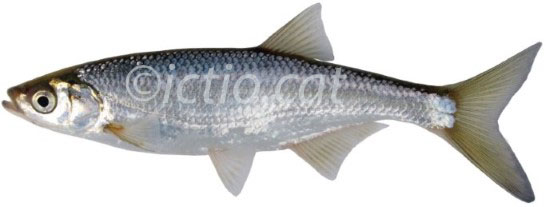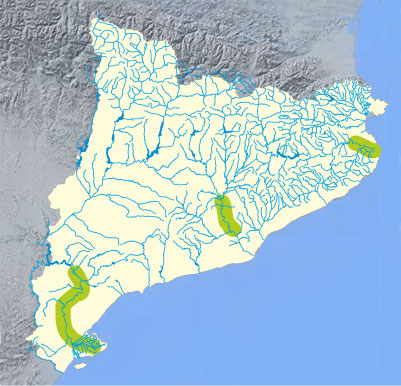Bleak
Alburnus alburnus

Small fish, adults measure between 10 and 20 cm. Body elongated and compressed laterally. Terminal and oblique mouth directed upwards. The dorsal fin is set back from the ventral fins. Very long anal fin. Bright silver coloration, with metallic reflections.
The range of natural distribution includes most of Europe, but it is introduced in Catalonia. It is currently present in virtually all basins and continues to expand.
It prefers the slow waters of the middle and lower reaches of rivers, but it is found mostly in reservoirs. Gregarious species, quite tolerant of organic pollution. It reproduces in spring. It feeds on small crustaceans and insect larvae. Its great capacity for proliferation produces strong competition with native fish, and is therefore one of the introduced fish that generates the most impact.
Distribution

Roach
Rutilus rutilus

It usually measures between 15 and 25 cm, maximum 40 cm. The body is tall and laterally compressed. The eyes are orange or red. The ventral and anal fins are orange or red.
It is distributed naturally throughout Europe and Asia, but it is introduced in Catalonia, where we can find it in the basins of the Muga, Fluvià, Ter, Llobregat and Ebro
It inhabits slow-flowing rivers, lakes and reservoirs. It is an omnivorous species that eats mainly invertebrates, but also aquatic plants and algae.
Distribution

Rudd
Scardinius erythrophthalmus

The rudd usually has a length of up to 20-30 cm. The body is very tall and compressed laterally, with relatively small head. The origin of the dorsal fin is behind the origin of the ventral fins. The body is golden in color, with the tail and fins of the lower body orange or red
It is native to most of Europe and western Asia, but in Catalonia it is introduced, distributed throughout most basins, although it is not very abundant.
It inhabits slow-flowing rivers, lakes and reservoirs, with abundant aquatic vegetation. It is an omnivorous species that feeds mainly on aquatic plants and algae, but also invertebrates.
Distribution

Pseudorasbora
Pseudorasbora parva

Measures at most 12 cm. The mouth is pointed upwards. The scales are very visible, as they are strongly pigmented. The back is blue and silvery on the flanks. Juveniles have a longitudinal dark line running through the entire body.
It is a species native to East Asia. It was introduced in 1999 in the Ebro delta. Later was detected in the rivers Ter and Llobregat, therefore, is expanding due to illegal introductions.
It lives in stretches of river of moderate current, lakes, reservoirs, irrigation canals, etc. It tolerates a certain level of organic pollution. The diet is omnivorous and consists of invertebrates, fish eggs and fry, plants, algae and organic detritus.
Pseudorasbora poses a very serious threat, as it is an invasive species that competes strongly with native fish.
Distribution

